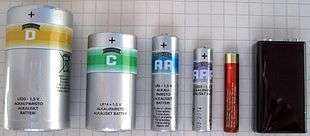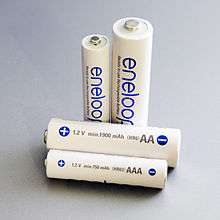AAA battery
An AAA or triple-A battery is a standard size of dry cell battery commonly used in low-drain portable electronic devices. A zinc–carbon battery in this size is designated by IEC as R03, by ANSI C18.1 as 24, by old JIS standard as UM-4, and by other manufacturer and national standard designations that vary depending on the cell chemistry. The size was first introduced by The American Ever Ready Company in 1911.[1]


A triple-A battery is a single cell and measures 10.5 mm (0.41 in) in diameter and 44.5 mm (1.75 in) in length, including the positive terminal button, which is a minimum 0.8 mm (0.031 in). The positive terminal has a maximum diameter of 3.8 mm (0.15 in); the flat negative terminal has a minimum diameter of 4.3 mm (0.17 in).[2] Alkaline AAA batteries weigh around 11.5 grams (0.41 oz), while primary lithium AAA batteries weigh about 7.6 g (0.27 oz). Rechargeable nickel–metal hydride (NiMH) AAA batteries typically weigh 14–15 g (0.49–0.53 oz).
Use
AAA batteries are most often used in small electronic devices, such as TV remote controls, MP3 players and digital cameras. Devices that require the same voltage, but have a higher current draw, are often designed to use larger batteries such as the AA battery type. AA batteries have about three times the capacity of AAA batteries. With the increasing efficiency and miniaturization of modern electronics, many devices that previously were designed for AA batteries (remote controls, cordless computer mice and keyboards, etc.) are being replaced by models that accept AAA battery cells.
As of 2007, AAA batteries accounted for 24% of alkaline primary battery sales in the United States. In Japan as of 2011, 28% of alkaline primary batteries sold were AAA. In Switzerland as of 2008, AAA batteries totaled 30% of primary battery sales and 32% of secondary battery sales.[3][4][5]
| Chemistry | IEC name | ANSI/NEDA name | Nominal voltage (V) | Typical capacity (mAh) | Typical capacity (Wh) | Rechargeable |
|---|---|---|---|---|---|---|
| Zinc–carbon | R03 | 24D | 1.50 | 540 | 0.81 | No |
| Alkaline | LR03 | 24A | 1.50 | 860–1,200[6] | 1.3–1.8 | Some |
| Li-FeS2 | FR03 | 24LF | 1.50 | 1,200 | 1.8 | No |
| Li-ion | 10440 | 3.6–3.7 | 350 | 1.3 | Yes | |
| NiCd | KR03 | 24K | 1.25 | 300–500 | 0.38–0.63 | Yes |
| NiMH | HR03 | 24H | 1.25 | 600–1,250[7] | 0.75–1.6 | Yes |
Other common names
References
- About Eveready
- "ENERGIZER E92 PRODUCT DATASHEET" (PDF). Retrieved 9 January 2014.
- Life Cycle Impacts of Alkaline Batteries with a Focus on End-of-Life - EPBA-EU.
- "Archived copy" (PDF). Archived from the original (PDF) on 2012-03-25. Retrieved 2015-02-23.CS1 maint: archived copy as title (link) INOBAT 2008 statistics.
- Monthly battery sales statistics - MoETI - March 2011.
- VARTA V4903 datasheet.
- "Your guide to types of household batteries". michaelbluejay.com. Retrieved 16 February 2018.
- Heinz Albert Keighne, Battery technology handbook, CRC Press, 2003 ISBN 0-8247-4249-4, page 374.
- Defence Standards: 61 Series - Electrical Wire and Power.
External links
- Specifications for Energizer alkaline AAA battery (E92)
- Brand Neutral Drawing Of Alkaline AAA Battery based on ANSI specifications
- Brand Neutral Drawing Of NICAD AAA Battery based on ANSI Specifications
- Brand Neutral Drawing Of NiMH AAA Battery based on ANSI Specifications
- Brand Neutral Drawing Of Rechargeable AAA Battery based on ANSI Specifications
